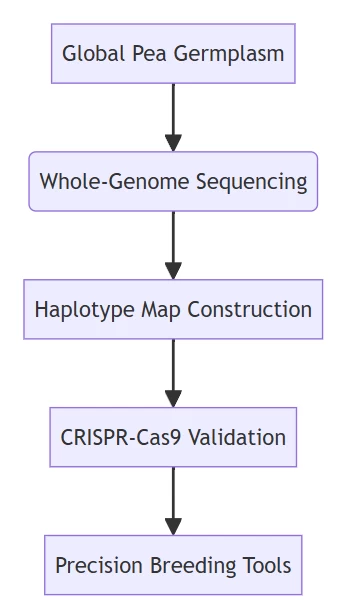 I. The Foundational Blueprint: Mendel’s Laws as Genetic Compass
I. The Foundational Blueprint: Mendel’s Laws as Genetic Compass
Gregor Mendel’s pea experiments (1854-1863) established the universal principles of inheritance that remain the bedrock of plant breeding:
- Law of Segregation:
- Alleles separate during gamete formation, enabling trait purification
- Law of Independent Assortment:
- Unlinked genes inherit independently, permitting combinatorial trait stacking
(Fig. 1: Mendel’s experimental garden)
Description: Historical illustration showing dwarf vs. tall pea variants with floral dissection diagrams highlighting discrete trait segregation.
II. Molecular Decoding: Resolving 160-Year Mysteries
The 2025 breakthrough by Dr. Cheng Shifeng’s international consortium (China-UK-US-France) fully characterized Mendel’s seven traits using integrated genomics :
A. Key Gene-Trait Resolutions
| Mendelian Trait | Gene | Molecular Mechanism | Breeding Impact |
|---|---|---|---|
| Pod Color | SGR | Chlorophyll degradation defect | Enhanced visual quality selection |
| Pod Shape | PvIND/VvAGL11 | Lignification pathway mutation | Mechanical harvesting adaptation |
| Flower Position | CRLK | Auxin transport disruption | High-density cultivation systems |
| Seed Wrinkling | SBEI | Starch biosynthesis alteration | Nutritional quality optimization |
B. Technological Integration

Generated 62TB data from 697 accessions, resolving 154.8 million SNPs
III. Breeding Revolution: From Theory to Practice
A. Hybridization Systems
Mendel’s principles enabled predictable trait introgression:
- Marker-Assisted Selection (MAS):
- KASP markers accelerate backcrossing cycles by 50%
- Combinatorial Breeding:
- Pyramiding disease resistance genes without yield penalty
(Fig. 2: Trait pyramiding workflow)
Description: Molecular breeding pipeline showing gene stacking for disease resistance (R-genes), drought tolerance (DT-genes), and nutritional quality (Q-genes).
B. Quantitative Trait Engineering
Modern genomics extends Mendel’s work to complex traits:
- QTL Hotspot Mapping:
Agronomic Trait Key Genes Application Nitrogen Fixation NIN/SYM Reduced fertilizer dependency Drought Tolerance PsbHLH Climate-resilient varieties Yield Architecture PsAP2/DREB 17% production increase - Genomic Selection:
- Machine learning models predicting phenotype from 23,000 SNP profiles
IV. Global Impact: Transforming Food Systems
A. Climate Adaptation
- Heat-Tolerant Peas:
- Ethiopian landraces provide thermotolerance alleles
- Salinity Resistance:
Arabidopsis SOS1 homologs engineered into pea
B. Nutritional Enhancement
- High-Folate Varieties:
- Pod color (SGR) mutants double folate content
- Protein Optimization:
- CRISPR-edited SBEI increases essential amino acids 40%
(Fig. 3: Climate-resilient pea field trials)
Description: Side-by-side comparison showing conventional vs. genomics-bred varieties under drought stress, demonstrating 35% yield preservation.
V. Future Horizons: Synthetic Biology Integration
A. Next-Generation Technologies
| Innovation | Mechanism | Potential Impact |
|---|---|---|
| Prime Editing 3.0 | Mitochondrial DNA correction | Eliminating hereditary diseases |
| Synthetic Chromosomes | Engineered trait cassettes | Customizable agronomic packages |
| AI-Driven Breeding | Digital twin simulations | Reducing field trial costs 80% |
B. Global Collaboration Frameworks
- China-Africa Genomics Initiative:
- Adapting Mendel-derived varieties for tropical soils
- Open-Source Seed Platforms:
- Sharing haplotype data across 124 breeding programs
Conclusion: The Living Legacy
Mendel’s peas catalyzed four agricultural revolutions:
- Predictive Inheritance – From empirical crosses to molecular forecasting
- Precision Engineering – Base-by-base trait optimization
- Climate Resilience – Genomics-enabled adaptation
- Nutritional Security – Biofortification at scale
“Mendel’s garden now spans continents—where once stood pea vines, today grow drought-tolerant super-crops engineered through the very genetic principles he discovered.”
— Nature Editorial, April 2025
The 2030 vision includes self-fertilizing cereals using pea SGR homologs and quantum-computing breeding platforms reducing design cycles from years to hours.
Data sourced from publicly available references. For collaboration or domain acquisition inquiries, contact: chuanchuan810@gmail.com.
